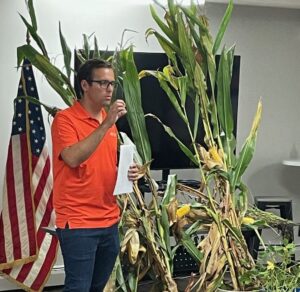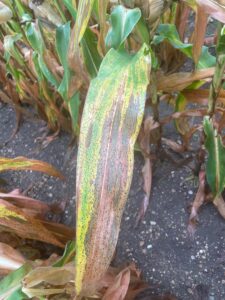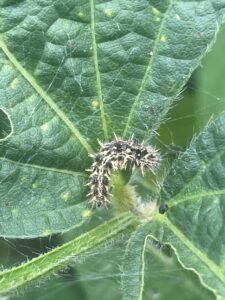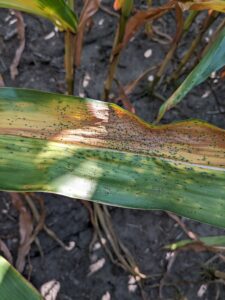Illinois Crop Update – August 30, 2024
Kathryn Seebruck – Commercial Agriculture Educator
Jo Daviess County
Soil Conditions: Mildly Dry (soil is drier than normal, plant growth may have slowed)
Soybeans are at R6-R7 throughout the area, and corn is at R4-R5. We have not had any significant rainfall events for a couple of weeks, leading to dryer conditions. I still have not heard any reports of or seen increased incidence of disease or insect issues. Some silage chopping has begun.
Russ Higgins – Commercial Agriculture Educator
Grundy County
Soil Conditions: Mildly Dry (soil is drier than normal, plant growth may have slowed)
The past three days featured almost unbearable 90 degree plus days, compounding extreme dry or drought conditions for the 2024 crop. It ended with a 1 inch plus rainfall for some in the Northeast on Tuesday night. Prior to the precipitation, both corn and soy were demonstrating heat stress. One of the oddities found while scouting our now mostly R6 (full seed) soy was thistle caterpillar (order Lepidoptera). The adult is known as the painted lady butterfly. Thistle caterpillars are not known to overwinter in Illinois but migrate north annually from the southern US and Mexico. The caterpillars form webs by tying leaves together with silk creating a protected area for them to feed. Almost always considered a sporadic pest, it rarely causes enough defoliation to warrant treatment.
Today, Dr. Boris Camiletti, plant pathologist with the University of Illinois, shared his observations on the 2024 growing season from a plant disease standpoint to a gathering of northeastern Illinois farmers. Diseased crop samples brought to the meeting were identified as tar spot, northern corn leaf blight, gray leaf spot, southern rust and white mold. In addition, Fusarium and Penicillium ear rots were found. Dr. Camilletti encouraged growers to continue scouting practices to aid in management decisions, make use of the Illinois Plant Clinic, and be on the watch for red crown rot in soy that it is progressing its way north in the state.

Figure 1: Dr. Boris Camiletti shares plant disease identification

Figure 2: 28 August, 2024 Corn leaf diseases

Figure 3: Thistle caterpillar
Meagan Diss – Commercial Agriculture Specialist
Warren County
Soil Conditions: Mildly Wet (soil is wetter than normal, local vegetation is healthy)
Well, corn sweat is the buzzword of the week and it’s been hot and humid. We’re seeing some tar spot and other disease pressure popping up in fields. There’s a mix of weed pressure across the county with mild insect presence. Corn is R3-R5 depending on planting date and soybeans are R3/R4 again pending planting date. Overall, crops are looking good.
Reagan Tibbs – Commercial Agriculture Educator
Logan County
Soil Conditions: Near Normal
This week has brought significant heat and humidity to the area. Temperatures across Logan, Menard, and Sangamon counties soared into the mid to high 90s, with feels-like temperatures surpassing 100. This heat has caused significant changes to growing conditions across the area. While topsoil moisture is short, there is still some moisture further down that may likely take crops through to harvest. Early-planted corn has reached the dent (R5) stage, with the later-planted fields in the dough (R4) stage. The story is much of the same for soybeans. Early-planted soybeans have reached R5, with some even reaching R6.
Talon Becker – Commercial Agriculture Specialist
Ford County
Soil Conditions: Near Normal
The corn and soybean crop across Ford County is progressing well, with most fields reaching the later stages of grain fill. The drawn-out planting season is still apparent, with a range of crop maturity observed across the county. Some bean fields are beginning to drop leaves (late R6) while others are still filling pods (R5). Of corn fields surveyed, most were in the early to mid-dent (R5) stage, but I found a few fields still in dough (R4). Soybeans fields visited showed minimal signs of disease. This was also true for most corn fields, although a couple fields I visited in the northern part of the county were showing signs of tar spot (confirmed by the Plant Clinic), among other foliar diseases. Soil moisture conditions in fields surveyed were good, with the crop showing little to no moisture stress despite base temps in the 90s during my survey.

Figure 4: Corn leaf with tar spot stromata





